While Zurvár Arèáná is at the far end of the spectrum, it is nonetheless a close Earth analog. Therefore it is only to be expected that it's solar system would also closely correspond with that of Earth.
When the planet was surveyed and settled in the ST0060's names were required for the various bodies visible in its sky. The job of determining these fell to the Konsâtèum Koreb mon Eket Akaláret (Konsâtèum Council on Astronomical Names) or KKEA, established after the Mirandá incident of ST0064 as a subsidiary body of the Konsâtèum Koreb mon Eket man Tomenak (Konsâtèum Council on Names and Navigation) or KKET.
This document runs through the names assigned to these bodies and the linguistics and reasoning behind them.
Altáká - The Sun
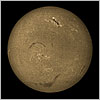
Altáká is simply the Zurvár word for "sun". As with most natural languages this is a distinct and separate word from "star" (minak), although in the last few centuries (with the realisation that a sun is a star) this distinction has become somewhat blurred. The sun of Zurvár Arèáná was officially designated Altáká as one of the first actions of the KKEA in ST0065.
There was actually a small but vocal faction in the Council that advocated the title Sûlminak or
"Daystar*sûln - Day. minak - Star."
for the sun, arguing that the traditional name was inaccurate and unscientific, and created the impression that the sun was somehow separate from or superior to any other star. This was rejected as scientific pedantry and on the basis that the general populace would probably continue to call the sun Altáká anyway, regardless of any alternate name chosen by the Council.
Altákerek - The Sunmote
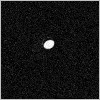 Zurvár Arèáná's Mercury analog was christened
Zurvár Arèáná's Mercury analog was christened Altákerek (Sunmote) by the KKEA in mid ST0065. The name is derived from altáka (sun) and kerek (speck, particle, piece of grit) and refers to the planet's closeness to the sun and difficulty of observation. In fact the planet was not actually spotted until early ST0066, the name was assigned on the assumption that it existed based on comparison with Earth.
Altákerek is slightly smaller than Mercury, and orbits slightly closer in to Altáka, accounting for its low profile. It is usually only visible to the naked eye for a few nights a year, when it orbit places it at slightly more than a right angle to Zurvár Arèáná. Even then it is only visible for an hour or so after sunset or before sunrise, and most inhabitants of Zurvár Arèáná have never seen it.
The same resolution that named Altákerek reserved the name Hašek (Cinder) for an Inter-Altákerek planet theorised by some astronomers. Orbital studies have shown that if Hašek exists it can be no more than a few dozen kilometres across, and most astronomers now regard it as non-existent. Supposed observations of Hašek recorded by amateur astronomers in ST0072 and ST0086 have been shown to be misidentifications of known bodies, and it was finally removed from the KKEA catalogue in ST0089, although the name does remain in reserve.
Mirandá - Miranda
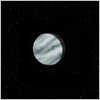 The Venus analog,
The Venus analog, Mirandá, was first
recognised*Later calculations and comparisons with MKD logs indicated that the planet must have been seen by at least four other Survey Teams, but none recognised it as more than a particularly bright star.
by an
MKD*MKD - Mametak Kelkertaklá Depe? (Settlement Survey Team). Prior to the arrival of the first settlers on Zurvár Arèáná in ST0066 (1966 AD) the Konsâtèum sent a number of survey teams to the planet to map it's surface, find locations for settlements and to assess any hazards. The teams operated under the auspices of the Konsâtèum Kredatèn Mametak Kelkertaklá (Konsâtèum Settlement Survey Authority) or KKMK, and followed the procedures laid out in the KKMK Mandate. Each team consisted of between eight and twenty members, and tours on the planet lasted between two and four months.
member named Caklan Tâban Kèklosavik in late ST0064. He was a keen amateur astronomer and was almost certainly the first person to bring an astronomical
telescope*A four inch chromatically corrected refractor. This instrument was tracked down and purchased for the KKEA museum in Bal in ST0087 (1987 AD).
to Zurvár Arèáná.
According to the commonly accepted account Tâban woke up early one morning and noticed a particularly bright star close to the eastern horizon. Suspecting that this was a planet (either Zurvár Arèáná's Venus or Jupiter analog) he trained his telescope on it, and was able to perceive a distinct disk. The featureless surface and lack of visible satellites convinced him that he was observing the Venus analog, and he duly recorded this in the team log.
On consulting the team's copy of the KKMK mandate later that morning he could find nothing prohibiting his naming the new planet as he saw fit. Before the day was through he had filled in the necessary paperwork to christen the planet Mirandá after his girlfriend (a Konsâtèum research physicist back on Metaphysica).
When the papers came to be processed much debate was prompted on whether the name should be officially recognised. The KKMK Mandate stated that the discoverer of any feature could assign whatever name they wanted to it, subject to KKET approval, providing the date of discovery and location were clearly defined. There were already dozens of islands, points, bays, headlands and creeks all over the planet named after family, friends and partners of MKD members, however the Mandate was not specific as to whether it's scope was limited to just terrestrial and oceanic features, or could be extended to cover astronomical objects.
After several weeks of deliberation the council reached a compromise - the name would be
accepted*The fact that one of the commonly accepted etymologies for the name Mirandá is "dark jewel" or "jewel of darkness" (mi'rè + endá) - an appropriate name for the brightest object in Zurvár Arèáná's night sky - no doubt influenced their decision.,
but the Mandate would be amended to explicitly limit its scope to Zurvár Arèáná itself. Several other names hurriedly assigned to stars and lunar features by opportunistic MKD members were unceremoniously thrown out, and a new sub-committee established to consider astronomical naming procedures. This new body became the Konsâtèum Koreb mon Akaláret Eket (Konsâtèum Council on Astronomical Names).
While it would be nice to report that Mirandá and Caklan lived happily ever after, they actually broke up acrimoniously about three years later. Shortly afterwards Tâban applied to the KKET to have the planet renamed. His request was denied, leaving him to deal with probably the most permanent reminder of an ex-partner ever devised by Human or Zurvár.
The existence of a body in Earth's solar system (a moon of Uranus) also named Miranda is merely a coincidence.
Emer Arèáná - The Night Planet
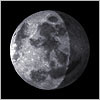 Zurvár Arèáná's moon was given the name
Zurvár Arèáná's moon was given the name Emer Arèáná by the KKEA after three years of heated debate in ST0068. The council had been split into numerous factions each favouring a different title including Emer Altáka (The Night Sun), Lûná (from the Earth Latin "Luna"), Akiritan (Sky Beacon), Su'ref Kiritáklan (Home Satellite) and Kerez Táká (The Pale Face). This conflict can be attributed to the fact that the Zurvár had never settled on a planet long enough to acquire a simple and unambiguous word for "moon".
The stalemate was resolved when it became clear that the growing population of settlers (arriving on Zurvár Arèáná from late ST0066 onwards) had come up with their own name for the body, Emer Arèáná or "The Night Planet". The various factions agreed to this clear, descriptive, unambiguous and (more importantly) non-partisan title, and it was made official in late ST0060.
In some areas of Zurvár Arèáná an alternate name is used, Emer Rèaklan (The Night Surfer). This title, from rèaklá (to ride a surf
board*An alternative translation is hence "Night Rider", but this is the kind of thing any serious type of linguist does their best to avoid.),
refers to the fancied resemblance of the satellite's markings to a humanoid figure standing on a board. The elongated maria to the figure's upper left is said to be an accompanying dolfin (Cetacean).
Konsâtèum Arèáná - The Konsâtèum Planet
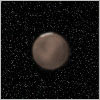 In what many consider a case of extreme self aggrandisement the
In what many consider a case of extreme self aggrandisement the KKEA named Zurvár Arèáná's Mars analog Konsâtèum Arèáná (The Konsâtèum Planet) in ST0065 as "a lasting memorial to the Konsâtèum's role in the settlement of Zurvár Arèáná". While this name has stuck officially, many Zurvár refuse to use it, referring to the planet instead as Arèáná Kirû (The Red Planet) or Minak Kirû (The Red Star).
No satellites have yet been detected around Konsâtèum Arèáná, but the KKEA has reserved the names Keredár (Order) and Tolákat (Prosperity). It is a common pun to refer to these theoretical moons as Karatár (Domination) and Kolarat (one who speaks authoritatively on a subject without having all, or any of the facts).
Akiritan - The Sky Beacon
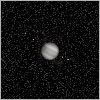 The largest planet in the Zurvár Arèáná system, the Jupiter analog was named
The largest planet in the Zurvár Arèáná system, the Jupiter analog was named Akiritan (Sky Beacon) in ST0068. This name was one of those originally suggested for the moon, but was recycled as an appropriate label for the (periodically) second brightest object in Zurvár Arèáná's night sky (after Mirandá).
The main difference between Akiritan and Jupiter is that the former seems to have no equivalent of the "Great Red Spot", a prominent and famous storm feature. It does feature many smaller white spots, a few of which are discernible from Zurvár Arèáná with only a small telescope or binoculars.
Also visible with binoculars are Akiritan's four largest satellites, which appear as bright "stars" around the planet. These have been christened Mon Kàdašlan (The
Dancers*From the verb kàdašlá "to dance". Noun forms of verbs in Zurvár (that is the name for something that carries out the verb) are created by the suffix "-an" for an inanimate object, and "-it" for animate objects. So a planet or moon that dances is a kàda?lan, while a person that dances is a kàdašlit.)
in reference to their constant and intricate position changes, which can be observed over a period of only a few hours.
Strûnarit Arèáná - The Metaphysician Planet
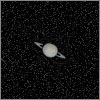 The same resolution that named
The same resolution that named Konsâtèum Arèáná also named Zurvár Arèáná's Saturn analog Strûnarit Arèáná (The Metaphysician Planet), as a tribute to the ceding of Zurvár Arèáná to the Zurvár by the Metaphysician's Guild in ST0062, and the Guild's continuing assistance in surveying and settling the planet. This name was far less controversial, and was generally accepted by the settlers.
In general usage the name is often corrupted to Strûnaritnà Arèáná (The Metaphysician's Planet), or Strûnaritnà Minak (The Metaphysician's Star), however the official title remains as given.
There have been several sightings of a satellite orbiting Strûnarit Arèáná. This is presumed to be a Titan analog, but as of yet is has not been granted an official title.
Mon Arèáná Safárè - The Distant Planets
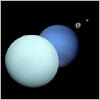 Systematic telescopic surveys on Zurvár Arèáná are in their infancy, and so far any planets outside the orbit of
Systematic telescopic surveys on Zurvár Arèáná are in their infancy, and so far any planets outside the orbit of Strûnarit Arèáná have not been observed. However it is expected that analogs for Uranus, Neptune and (probably) Pluto and Charon exist. The KKEA has not designated individual names for these bodies, instead they are referred to as Mon Arèáná Safárè (The Distant Planets).
If an individual arèáná safárè needs to be referenced, the correct KKEA designation is Á-Sá-Zad, Ver, Rû or Tò (AS-1, 2, 3 or 4). Commonly however they are called by the names of their Earth analogs, Yoranus, Neptyûn,
Plûtò*Some literary minded Zurvár have taken to calling Á-Sá-Rû Yugoþ, however this name has no official standing.
and Ceron*As a word from ancient Earth Greek, Charon should actually be pronounced with a hard "ch", as "Keron". Most Zurvár able to read English however are unaware of this distinction. In addition the discoverer of Earth's Charon (Jim Christy) named it in part after his wife Charlene, hence planetary scientists in the know also tend to pronounce it Ceron..